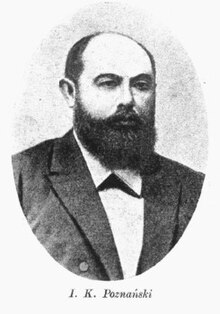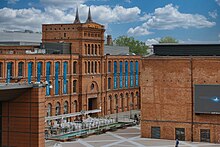Manufaktura
| Manufaktura | |
|---|---|
 Manufaktura Square | |
 | |
| General information | |
| Type | Department store |
| Architectural style | Romanesque Revival |
| Location | Łódź, Poland |
| Construction started | 1872 |
| Completed | 2006 |
| Owner | Union Investment Real Estate GmbH |
| Technical details | |
| Floor area | 270,000m² (2,906,256sq ft) |
| Design and construction | |
| Architect(s) | Hilary Majewski |
| Architecture firm | Virgile&Stone |
The Manufaktura is an arts centre, shopping mall, and leisure complex in Łódź, Poland. A major tourist attraction of the city, it includes the largest public square in Łódź, which acts as a venue for cultural and sports events.[1]
The Manufaktura opened on 17 May 2006, after 5 years of planning and the subsequent 4 years of construction. The total area of the complex is 27 hectares (67 acres). The work involved the renovation of an old textile factory building. The Manufaktura is located in the central part of the city, in the former industrial complex founded by Izrael Poznański, which is known also as the filming location of the novel by Władysław Reymont titled The Promised Land about the industrialization of the city of Łódź.[2]
History
In 1835, Kalman Poznański and his one-year-old son, Izrael, moved to Lodz from Aleksandrów Łódzki. Kalman owned a market stand at Stary Rynek in Lodz, where he sold various spices and fabrics. During that time, the Lodz industrialists grew in money and power - as the Russian market for fabrics, mainly cotton, increased. When Izrael Poznański inherited his father's company, he also decided to reshape and expand his business. He bought the plots around Ogrodowa Street, where he built the weaving plant in 1872. During the next 25 years, he expanded to a new complex consisting of weaving plants, spinning mills, a bleachery, power plant, finishing plant, dyehouse, warehouses, fire station and a company store. He also built houses, a hospital, a school and a community centre and canteen for thousands of his workers.[3]

His acquired wealth allowed him to finance many local investments – his own palace, the palaces for his sons (Maurycy and Karol), hospitals, one synagogue (no longer existing – it was destroyed by the Nazis during World War II). Poznański died in 1900 - his assets being estimated at about 11 million roubles. [4]

The development of industry was halted by series of events: workers' strikes (1905), World War I, the German occupation, the political changes in Russia. The last one, completely blocked Russia as a market for the products manufactured in Lodz. Then Great Crisis of the 1920s came and Poznański's company fell into debt, it was acquired in the 1930s.

When World War II ended, the Lodz factories underwent nationalisation and worked for the demands of communist Poland. Over the years, Poznański's complex changed name – first to The Julian Marchlewski Cotton Works and later to Poltex. In the 1970s, it came under the protection of the conservation officer. In 1975, the Poznański palace started serving as a seat for Museum of the City of Lodz. The political transition of the 1990s resulted in numerous bankruptcies, Poznański's complex included. lt was put into liquidation and its buildings fell into ruin.
The last Poltex director, Mieczysław Michalski, wanted to save the buildings from further deterioration and searched for investors willing to modernise Poznański's complex. In 1999, the complex was bought by French company Apsys. The revitalization of the complex costed ca. EUR 200 million. Manufaktura as it is known today (the name proposed by the students of Lodz universities) was opened on 16 May 2006.
Revitalisation

In 2012, Manufaktura was bought by the German investment fund Union Investment Real Estate GmbH. The transaction is estimated at EUR 350-400 million.[5]
The Manufaktura complex today is the direct result of Poland's largest renovation project since the reconstruction of Warsaw's Old Town in the 1950s (after World War II).[6]
Manufaktura is a tightly-knit complex of 13 historic buildings and a newly built shopping mall. The complex spans over 27 hectares. It is a combination of modern buildings made of glass and aluminium with Lodz's traditional architecture.

Revitalisation in numbers:[7]
- over 2.5 thousand workers were engaged in restoration of historic buildings and their brick façades and in raising a modern shopping mall,
- 45,000 m² brick façades renovated,
- 12,500 m² metal windows renovated,
- 95,000 m² new constructions erected.
The restoration of complex values was supervised by a conservation officer. In total 90,000 m² historic interiors were renovated and 600 trees planted. The project costed ca. EUR 200 million.
Organization

The revival was aimed at preserving the place's historical atmosphere, which is why the Manufaktura is now dominated by industrial architecture, with unplastered red brick buildings. The complex's trademark is the old, five-storey spinning mill in Ogrodowa Street, built between 1877 and 1878 (which explains the name of the complex). In 2009, a four-star Andel's hotel opened there. All the other buildings of the complex keep a similar style, but are of a lesser size. The exception to this is the main shopping hall, which is a new structure made of glass and steel. It is lower than the surrounding brick buildings, and therefore, it cannot be seen from the outside.[2]
One of the entrances to the Manufaktura complex leads through the ancient, triumphal arch-like gate of the old spinning mill. The whole complex, with its concept of mixing the old and the new, was designed by the British firm Virgile & Stone from London, in collaboration with the French architecture firm Sud Architectes from Lyon. The original industrial buildings were designed by the Łódź architect Hilary Majewski in 1872.[2]
Services
The Manufaktura hosts over 300 stores, malls, restaurants, pastry shops, cafes, pubs and other services. The service sector extends over 12,000 m². The entire complex has a surface of 270,000 m², making it Poland's second largest only to the Old Market Square in Kraków. Its large square features Europe's longest fountain at 300 meters. Clients can go along the complex with two trambuses.[2]
The heart of Manufaktura is the three-hectare Market which in summer is covered with beach and in winter with ice rink. The Market also serves as a host to many concerts and sport activities.[8]
Besides the commercial area, the Manufaktura includes a restaurant complex, car parks, a cultural centre (including the MS2 branch of The Museum of Art in Łódź, a science museum, a Factory Museum, and the Museum of the City of Łódź – the last of which is situated in the neighbouring Izrael Poznański Palace), and an entertainment centre (featuring a multiplex cinema, a bowling alley, a climbing wall, a fitness club).[2]
- Manufaktura, shopping mall building
- Manufaktura, shopping mall building

See also
References
- ^ Cudny, Waldemar (2016). "Manufaktura in Łódź, Poland: An Example of a Festival Marketplace". Norsk Geografisk Tidsskrift - Norwegian Journal of Geography. 70 (5): 276–291. doi:10.1080/00291951.2016.1239654. eISSN 1502-5292. ISSN 0029-1951. (pp. 282-283)
- ^ a b c d e "Manufaktura in Łódź". Poland.travel National Tourist Office (official website). pp. 1 of 2. Retrieved 26 November 2013.
- ^ "MANUFAKTURA - ABOUT US". en.manufaktura.com. Retrieved 2023-07-03.
- ^ "Poznański Izrael Kalmanowicz | Virtual Shtetl". sztetl.org.pl. Retrieved 2023-07-03.
- ^ "Union Investment acquires Manufaktura (PL)". europe-re.com. 2023-06-20. Retrieved 2023-06-20.
- ^ "Manufaktura | Sightseeing | Lodz". www.inyourpocket.com. Retrieved 2023-05-18.
- ^ "MANUFAKTURA - ABOUT US". en.manufaktura.com. Retrieved 2023-05-18.
- ^ "MANUFAKTURA - ABOUT US". en.manufaktura.com. Retrieved 2023-06-20.
- The Manufaktura's website in English. Featuring Timeline of history, 1851–2006 at En.Manufaktura.com


